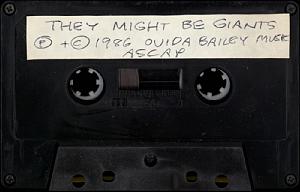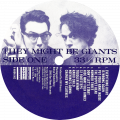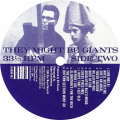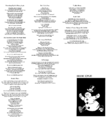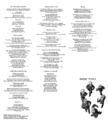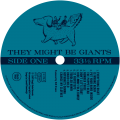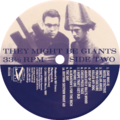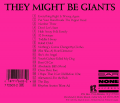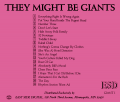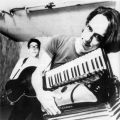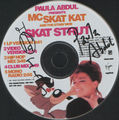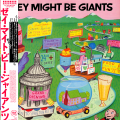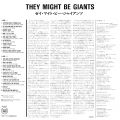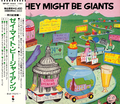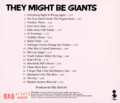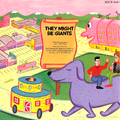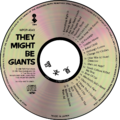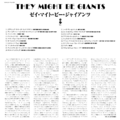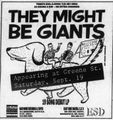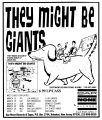They Might Be Giants (Album)
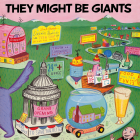 |
Studio album by They Might Be Giants | |||||
| First released | November 4, 1986 Release details / collectors: Show | Hide |
Tracks | 19 | |||
| Label | Bar/None / Restless | Length | 38:29 | Next album | Lincoln | |
They Might Be Giants, often referred to by fans as the Pink Album, is the first studio album by They Might Be Giants, released in 1986 on the fledgling Bar/None label.
Purchase[edit]
Seller  |
Format | Price | Link |
| Download | 
| ||
| Black Vinyl | 
| ||
| Pink & Green Vinyl | 
| ||
|
| |||
| AAC | $9.99 | 
|
Description[edit]
Background[edit]
Since 1983, They Might Be Giants had been recording several backing tracks to use as the rhythm section for their live performances around New York. By 1985, the band had written, demoed and performed most of the material heard on They Might Be Giants, and had accumulated enough recordings to create a self-released cassette-only album[1], the 1985 Demo Tape. The cassette was made with the help of Bill Krauss, who had been working with the band since 1983 as soundman and producer[2], and engineer Alex Noyes, who had granted the band access to record new material after hours[3] at Studio PASS from as early as January 1985[4]. The self-titled cassette was released on July 4th, 1985 and was distributed by the band at live shows[5], as well as through mailing order[6]. A copy of this tape eventually ended up in the hands of Michael Small, a reviewer for People magazine, who reviewed the tape in the magazine's June 30th, 1986 issue.
Sometime in late 1985, future Bar/None Records partner Glen Morrow was introduced to They Might Be Giants through Margaret Seiler, and had gotten the band gigs at the Peppermint Lounge and Danceteria[7]. He was contacted by the band in 1986 after Tom Prendergast had established Bar/None, with the label's first release being a record from Morrow's band, Rage To Live[8][9]:
They came to us and said they wanted Tom to put out their record for them. I wasn't even part of Bar/None yet. But I liked them and I got Tom to go see them. A lot of people were offended by the fact that they played with backing tapes, but I thought, hey, here's an act we can put in all those rock discos that will sound great there. And you had a little live music, a guitar and an accordion, and a really amusing live show. And you couldn't deny the songwriting. So it totally made sense to me.
Not long after Prendergast had seen the band live at CBGB with Morrow[10], They Might Be Giants would become the first band to be signed with Bar/None Records.
Recording[edit]
They Might Be Giants and its demos were recorded on 4-tracks at the apartments of John Flansburgh and John Linnell[11] and on 8-track at after hours sessions at Studio PASS[12] with Krauss as producer and Noyes as engineer. The album contained a majority of the songs previously featured on the 1985 Demo Tape, as well as new songs ("Hide Away Folk Family", "She's An Angel") recorded in 1986. Certain songs previously featured on the self-released cassette were not re-recorded ("Alienation's For The Rich", "32 Footsteps", "Number Three", "Toddler Hiway", "Rabid Child"), and received new mixes instead. Regarding "Toddler Hiway", John and John said: "We repeatedly failed to improve upon [it] using fancier equipment." Songs on the album from the band's repertoire that had not been previously released on the 1985 Demo Tape included "Rhythm Section Want Ad", released on various promotional demo tapes from early 1985, "Everything Right Is Wrong", released on the Wiggle Diskette in 1985, and "Absolutely Bill's Mood", which had been performed at the band's early shows under the title "I'm Insane"[13].
Some of the recording equipment used for the album included the Casio CZ-101 and Micromoog synthesizers, a mix of Yamaha RX11/15 drum machines and a Farfisa organ[14]. The Micromoog was used for the basslines[15] of various tracks, while the CZ-101 was used for "Chess Piece Face" and the whistling sounds in "Hide Away Folk Family"[16]. Drum patterns were sequenced on the RX machines directly, with Flansburgh detailing the recording process behind mixing and mastering the rhythm tracks for the album[17]:
Over the course of making our first album (made with essentially no money with tracks often built on 4 channel rhythm tracks constructed for our show and then used as the foundation for demos) our methods evolved with an eye on keeping sounds cleaner and cleared. The struggle of working against hiss and noise was constant, and was in no way charming. But for us in '86-'87 hiss still seemed preferable to early attempts at syncing systems. It seemed we were constantly walking into sessions where the people leaving were pulling their hair out having NEVER been able to get things to fully sync or having lost sync at the worst moment as they were trying to mix their master.
Two other synthesizers owned by Studio PASS were the Fairlight synthesizer and a Yamaha TX816, which Flansburgh described as “8 DX7s stacked upon each other to try to get away from the glassy thinness of the single instrument"[18]. Either one or both of these synthesizers were used to record "Rabid Child", while the Fairlight had previously been used by the band for "The Biggest One" and "Become A Robot" during sessions for the 1985 Demo Tape. For the band's final recording sessions for They Might Be Giants, they had moved to Al Houghton's Dubway Studio[19], where the full album would be mixed. One of the later recordings at Dubway was a new re-recording of "Don't Let's Start". Flansburgh would recall recording the song on Tumblr in 2014:
"It was recorded to an 8 track reel to reel machine (7 live tracks and a sync track for the drum machine which played "virtually" through the mixing console) and mixed through a small Ramsa board. Al, Bill Krauss, JL and me all took part in various fader and machine moves during mixing. Doing an analog mix back then was an "all hands on deck" deal — a very fraternal and often giddy activity. It usually seemed to start off tense, got fun, then both, as they always took a little longer than we planned."
Guests on the album included Margaret Seiler, who provided the lead vocal on "Boat Of Car", Peter Pearmain Thomson on backing vocals for "(She Was A) Hotel Detective", and musician Eugene Chadbourne, whose guitar solos for "Absolutely Bill's Mood" were recorded over-the-phone directly from Dubway's answering machine. Flansburgh explained the story behind getting Chadbourne onto the album in a 1997 interview:
We'd done a show with him where his amp had blown up and he asked if he could borrow my amp. I was really reluctant to let him borrow my amp. I didn't know him at all. He was like, "Don't worry. It won't be bad." And then he plugs in this electric rake with like, a cheap pickup on it. So he's playing it through my amp making this completely hellish feedback sound really loud. Then he gave me back my amp and it wasn't... broken. But I think I made it clear that he owed me one. So we were figuring out the arrangement for the song, I thought, "Hey, I'll give him a call. He borrowed my amp." And that was the deal.
Two songs known to have been left off of They Might Be Giants were "Fake Out In Buenos Aires" and "They Might Be Giants". Although the latter song had previously appeared on the 1985 Demo Tape, the band did not include the song on the album "because it seemed too weird"[20], while "Fake Out In Buenos Aires" was left off because the band "thought it would have appeared indulgent."[21] "They Might Be Giants" would later be re-recorded for Flood, while the original recording for "Fake Out In Buenos Aires" would be released on Then: The Earlier Years.
Packaging[edit]
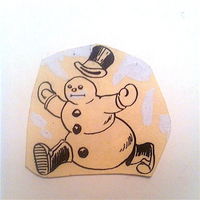
The cover artwork for They Might Be Giants was done by Rodney Alan Greenblat, an artist who had been a part of the East Village art scene at the time[22], and knew of TMBG as a local band. Flansburgh said of contacting Greenblat[23]:
I actually got his phone number from a mutual friend and asked him if he would be interested. He was very generous with his time and effort.
Greenblat has stated that he was inspired by Dr. Seuss when designing the cover. An alternate version of the dog illustration featured on the cover artwork was also created by Greenblat to promote the album, and is featured on various album advertisements from late 1986 to early 1988.
The lyric inserts for the LP contain two different artworks. The snowman on Side One of the insert was taken from a trash can from Flansburgh's job at Macmillan Publishing, where it was then altered to be given a "more ambivalent expression"[24]. The artwork on Side Two is from the Boy Scout Handbook, which featured an activity the band thought looked "very tribal and strange"[25]. Photographs featured on Side One and Two of the vinyl release were taken by Robyn Stoutenberg, who had done photography for the band as early as 1985, and is credited on various posters and promotional material released around the same time[26].
On the back cover, it states that the album is dedicated to James McIntyre, a high school acquaintance who purportedly greatly influenced the Johns. McIntyre died of AIDS in May 1986.
Promotion and Release[edit]
To promote the album, They Might Be Giants first performed a show at the Saint on October 9, 1986 to celebrate both their signing to Bar/None Records and the upcoming release of their first album[27]. During this time, MTV had began to play the music video for "Put Your Hand Inside The Puppet Head"[28], directed by Adam Bernstein, which had been filmed and completed three months prior in July 1986[29]. Copies of the album with press packets were sent by Bar/None to radio programmers on November 1, 1986[30].
They Might Be Giants was released on LP and CD on November 4, 1986, with a release party for the album held at Darinka two days later. The album was distributed throughout the band's shows for the rest of that year, being placed up or on stage[31] or to be purchased in lobby areas[32]. The band would also gain publicity from MTV's airings of the "Put Your Hand Inside The Puppet Head" music video, which continued after the album's release. John Linnell would recall the video appearing in MTV before the album's release in a 2001 interview:
It was kind of a strange lucky thing for us... We were being played alongside these bands that were so completely different from us that it worked to our advantage. There were like Whitney Houston videos and Whitesnake and us in the middle, so it was a really great break for us.
In 1987, the band embarked on their first national tour, the "Bring Me The Head Of Kenny Rogers World Tour '87" to promote of the album. It was on this tour that "Don't Let's Start" would begin to be played commercially on radio stations, after a programming executive for WXDX had seen the band perform the song at the Electric Banana[33]. Due to the song's popularity[34], a new music video directed by Bernstein and a maxi-single EP would be made. They Might Be Giants would also be made available internationally in Europe, Japan and Australia through Rough Trade. The last single from the album, "(She Was A) Hotel Detective" would be released on May 5, 1988, followed by a music video directed by Bernstein featuring animation by Joey Ahlbum.
By this time, They Might Be Giants had finished recording for a new album titled Lincoln[35], featuring several songs written throughout the promotion[36] of and before the release of the band's first album. The importance of both albums led to them being re-released in their entireties in 1997 alongside a number of demos and rarities on the Restless compilation Then: The Earlier Years. However, the version of "Don't Let's Start" on that compilation is the single version, rather than the album version.
Track listing[edit]
| # | Title | Length | Lyrics | Guitar Tab |
|---|---|---|---|---|
| 1 | Everything Right Is Wrong Again | 2:20 | 
|

|
| 2 | Put Your Hand Inside The Puppet Head | 2:12 | 
|

|
| 3 | Number Three | 1:27 | 
|

|
| 4 | Don't Let's Start | 2:36 | 
|

|
| 5 | Hide Away Folk Family | 3:21 | 
|

|
| 6 | 32 Footsteps | 1:36 | 
|

|
| 7 | Toddler Hiway | 0:25 | 
|

|
| 8 | Rabid Child | 1:31 | 
|

|
| 9 | Nothing's Gonna Change My Clothes | 1:58 | 
|

|
| 10 | (She Was A) Hotel Detective | 2:10 | 
|

|
| 11 | She's An Angel | 2:37 | 
|

|
| 12 | Youth Culture Killed My Dog | 2:51 | 
|

|
| 13 | Boat Of Car | 1:15 | 
|

|
| 14 | Absolutely Bill's Mood | 2:38 | 
|

|
| 15 | Chess Piece Face | 1:21 | 
|

|
| 16 | I Hope That I Get Old Before I Die | 1:58 | 
|

|
| 17 | Alienation's For The Rich | 2:25 | 
|

|
| 18 | The Day | 1:27 | 
|

|
| 19 | Rhythm Section Want Ad | 2:21 | 
|

|
2013 Australian bonus tracks[edit]
The 2013 Australian reissue included a selection of B-sides and rarities previously released on Then: The Earlier Years.
Trivia[edit]
- Many fans refer to this album as The Pink Album or Pink due to the pink background on the album cover, similar to The White Album by The Beatles, which is also fan-named but officially a self-titled album. In the early days of TMBG's internet-based fan community, it was occasionally called the Big Blue Dog album because of the illustration of the Johns riding a dog of such a nature [37]. It was also infrequently called Truth Or Sandwiches, in reference to the purple exit sign on the cover[38].
- Also due to the cover art, They Might Be Giants was initially mistaken by Tower Records as a children’s album. John Linnell[39]:
We put out our first album and it had this illustrated cover by Rodney Alan Greenblat. It looked to a lot of people like a kids' record. And this was something we were kind of horrified by because we were really not thinking we were doing something for kids at that time, in 1986, when the first record came out. And in fact Tower Records got our record and immediately stuck it in the children's section by mistake. And so we were really very, very protective of our image as a band for adults. We were really wanting people not to get confused and think it was somehow a kids' act.
- The font, Filmotype Metro, used on the cover came from a "photographically based system" generated by a "non-computer-based machine". This machine had "decorative fonts from the 50s and 60s when the machine was developed" and "were ubiquitous in newspaper print shops as well as publishing houses".[40] Other examples of Filmotype Metro can be seen at Fontsinuse.com [41]
- On the LP version of the album, the following side titles were used:
- Side 1: Johnny Call Home (718) 387-6962
- Side 2: 25 hours a day 6 days a week (718) 387-6962
- Briefly during initial releases of They Might Be Giants and other promotional material surrounding the album, the band had named their publishing company "Ouida Bailey Music" after their high school science teacher. It was changed back to "TMBG Music" not long after to avoid legal action[42], but the name can be found on the LP and first CD release, a promotional sampler for the album, and a videotape for "Put Your Hand Inside The Puppet Head"[43].
- The first pressing of the CD (on the East Side Digital label) contains a typo on the back: "Nothing's Gonna Change By Clothes."
- The European Elektra re-release of the album on vinyl has a typo on the Side 2 label, which calls the band "They Might By Giants."
- Elektra CDs and cassettes of the album replace "Don't Let's Start" with the single mix of the song, and the CDs feature incorrect track times on the back.
Image Galleries[edit]
Vinyl[edit]
Common Rough Trade label design
CD[edit]
Back of the ESD pressing
Picture from the European Rough Trade CD booklet
Japanese releases[edit]
Elektra CD inside cover, with the international Dial-A-Song number
Cassette[edit]
Advertisements [edit]
UK magazine ad for Elektra's re-release of the album, 1990
